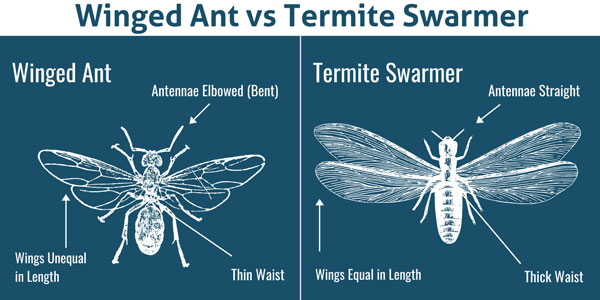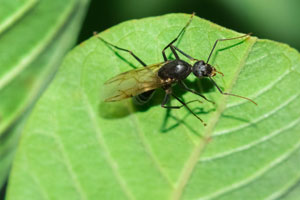If you think you’ve seen termites in or near your property, how can you be sure they aren’t carpenter ants? Both of these pests are wood-destroying insects that, in the swarmer stage, are commonly mistaken for one another. Termite and carpenter ant swarmers are active around the same time of the year and, from afar, look quite similar. Although they are both destructive, these wood-boring insects are quite different. To learn whether you may be dealing with termites or carpenter ants, read on for tips from the experts at Batzner Pest Control.
The Main Difference Between Wood-Destroying Insects
When it comes to these two wood-destroying insects, one is much more feared than the other.
- Carpenter Ants
- Typically establish nests in wood that is already in decay, and later expand into sound wood, insulation, or wall voids.
- Their damage is not usually visible. When it is, you can notice that the galleries they excavate appear to have been sanded.
- For the most part, carpenter ants do not create the extensive damage termites do.
- Termites
- Usually make their way into a structure around basement windows, doorways, under siding, porches, or any structure in contact with the soil.
- Established colonies can range from 60,000 to over a million workers and can consume nearly 5 grams of wood per day.
- Termites are significantly more dangerous than the carpenter ant, as they can cause much more damage in a short period of time.

What do Termites and Carpenter Ants Look Like?
In the swarmer stage, termites and carpenter ants look very alike. Carpenter ant swarmers are black in color with slightly red coloring at times. Their wings are translucent with a reddish-brown hue. The biggest difference is that carpenter ants measure 1/2″–5/8″ with antennae bent at a 45-degree angle.
Termite swarmers are dark brown to black in color and measure 3/8″ long including the wings. Their wings are a translucent to slightly milky or smoky color, may overlap, and are typically as long as or slightly longer than the body. This is an easy visual clue to differentiate them from carpenter ants.
What to Do When You Have Termites or Carpenter Ants
If you think you’ve spotted the signs of either termites or flying ants, it’s time to call the termite exterminators at Batzner Pest Control. Termites and carpenter ants alike are difficult to control without the expertise of a pest control expert. Our team can thoroughly inspect your Wisconsin home or business for wood-destroying insects and help protect you from them year-round!



